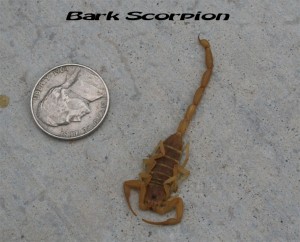Scorpions are nocturnal or diurnal, predatory animals that feed on a variety of insects and spiders, although tarantulas are known to prey on scorpions. Most are active at night, and spend their days where it is cool and moist under rocks, wood, tree bark or in burrows. Scorpions are generally active if nighttime temperatures are above 70°F. They are less active during winter and in summer during daylight hours.
The two main scorpion species we have in Northern Arizona are the Stripe-Tailed Scorpion, aka the Devil Scorpion, and the Bark Scorpion. Both will sting if molested. The most common route for these guys to get into your home is through the door seals (loose seals, especially the door sweep under the door). Regular pest control service helps control these guys and their food source.
Scorpions are nocturnal or diurnal, predatory animals that feed on a variety of insects, spiders, centipedes, and other scorpions.
Bark Scorpion

The typical “bark” or “crevice” scorpion is encountered in many places, most commonly under rocks, logs, tree bark, and other surface objects. They’re common in many habitats but almost always in rocky areas.
The venom of the bark scorpion may produce severe pain and other serious symptoms. Antivenin is available. Certain people may be allergic to the venom and can experience life-threatening side effects when stung (as occurs with bee stings).
The characteristics of the Bark Scorpion are:
- Body is narrower
- Thin long claw
- Stinger has a secondary smaller barb on it
- Tail segments long and skinny
Stripe-Tailed Scorpion

The Stripe-tailed Scorpion, or Devil Scorpion) is typically found under surface objects such as sleeping bags, shoes, etc. where it digs a short burrow or “scrape” for protection. This species is normally a burrower, digging burrows about one meter deep in gravel soils. This is the one we see most often in the Verde Valley.
The characteristics of the Stripe-Tailed Scorpion are:
- Wide body
- Thick short claw
- Stripes on the tail
- Tail segments short and thick
Scorpion Prevention
The best way to keep scorpions out of your home is to make the house surroundings less desirable for them to begin with.
- Remove all hiding places from around the building such as: trash, logs, boards, stones, bricks and other objects.
- They like to hide in wood, so if you bring firewood into the house, place it directly on the fire.
- Keep grass closely mowed near the home. Prune bushes and overhanging tree branches away from the structure. Tree branches can provide a path to the roof for scorpions. Minimize low growing ground cover vegetation.
- Store garbage containers in a frame that keeps the containers above the ground.
- Caulk around roof eaves, pipes and any other cracks that would allow them to get into the building.
- Install weather-stripping around loose fitting doors and windows, and make sure the door jamb below the door is tight-fitting.
- Plug weep holes in brick veneer with steel wool, pieces of nylon scouring pad or small squares of screen wire.
- Keep window screens in good repair. Make sure they fit tightly in the window frame.
For more information about scorpions, see this publication on Scorpions from the University of Arizona Cooperative Extension.
